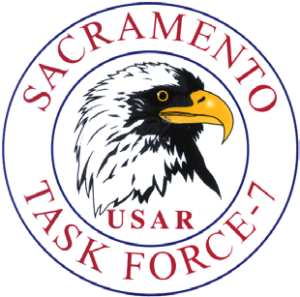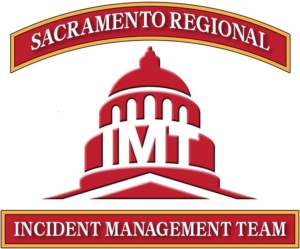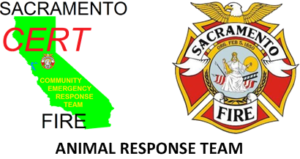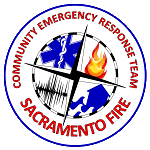Sacramento CERT training is provided to applicants at no cost. Funding for training is made possible through grants the Fire Department receives from the Department of Homeland Security, Sacramento CERT fundraising events, and donations from citizens and companies in the Sacramento region.
We offer both CERT qualification training courses and specialized advanced training.
CERT Basic Qualification Training
The Level III Community Emergency Response Team (CERT) Program educates people about disaster preparedness for hazards that may impact their area and trains them in basic disaster response skills, such as fire safety, light search and rescue, team organization, and disaster medical operations. Using the training learned in the classroom and during exercises, CERT members can assist others in their neighborhood or workplace following an event when professional responders are not immediately available to help.
This is the entry level qualification for the Sacramento Community Emergency Response Team.
This program involves training over a three week period, typically with Tuesday night and Saturday sessions.
The courses to be covered are:
- Unit 1: Disaster Preparedness
- Unit 2: Fire Safety and Utility Controls
- Unit 3: Disaster Medical Operations – Part 1
- Unit 4: Disaster Medical Operations – Part 2
- Unit 5: Light Search and Rescue Operations
- Unit 6: CERT Organization
- Unit 7: Disaster Psychology
- Unit 8: Terrorism and CERT
- All units – Combined Materials (Warning: 3.35MB file)
Students can click on any of the links above to access the FEMA materials used for these courses.
Level III CERT qualification is a pre-requisite for all advanced training, and for participating in any CERT activities.
Classes are scheduled periodically. Please use the “Join CERT” form to request being added to the roster for our upcoming classes.
The Sacramento CERT team is organized into Battalions based on their home address (north or south of the American River). This gives the members a chance to get to know everyone else in their area, and to meet and plan what they would do in the event that something were to happen in their area. Those belonging to the City CERT and residing outside the city limits are welcome to associate with the closest group to their residence and to be an active member of CERT.
Sacramento CERT can be deployed during disasters within the City/County of Sacramento, or anywhere in California for up to 2 weeks. To qualify to deploy, members must meet the FEMA CERT Volunteer Type 2 or Type 1 standard of training.
This consists of the Basic CERT course above, plus additional in-person and on-line classes listed below.
FEMA CERT Volunteer Type 2 members can be deployed within the City of Sacramento.
FEMA CERT Volunteer Type 1 members can be deployed anywhere in California.
FEMA CERT Volunteer criteria (set by FEMA) are listed below. Sacramento Fire requires FEMA CERT Volunteer training plus the following local required classes to be completed before being sworn in:
FEMA Independent Study Classes:
To enroll in FEMA Independent Study classes (and CSTI classes), you must first secure your FEMA Student ID. You can do so by registering on this site.
SEMS Classes:
The California Specialized Training Institute (CSTI) web site hosts the Standardized Emergency Management Class G606 on their web site. For instructions on how to register on the CSTI web site and how to find the class, follow the instructions found on this document.
American Red Cross Classes:
The American Red Cross web site hosts the following required on-line classes:
- Shelter Fundamentals
- Disaster Cycle Services: An Overview
To register on their training web site and for instructions on how to find the classes, follow the instructions found in this document.
CERT Supplemental Classes:
Sacramento Fire requires CERT members to attend three instructor led training courses:
- Wildland Fire Urban Interface (WFUI) with Fire Shelter
- Hazardous Materials First Responder Awareness (HAZMAT FRA)
- Flood and Swift Water Awareness (FSW)*
These classes are offered to Sacramento CERT Basic Academy graduates and are offered twice a year.
*FSW is only delivered by Sacramento Fire and is often scheduled during fire season. If members complete WFUI and HAZMAT FRA but are unable to get into the FSW class, they will be listed as “Probationary” members and will be able to deploy to disaster mobilizations, but will not be given operational duties that will bring them within 10 feet of waterways or flood zones.
FEMA National Qualification System
The FEMA Natiuonal Qualification System (FQS) is a performance-based qualification system that gives employees the opportunity to demonstrate and document their knowledge and skills in their specific incident management or incident support positions. Performance-based training refers to incident-related performance (at a disaster, incident, or scheduled exercise) that demonstrates the employee’s knowledge, skills, and actual performance, as documented in the position task book for the specific position, during these types of situations.
To become qualified for an incident management or incident support position, each employee is evaluated on the job. FQS standardizes the qualifications for positions across the Agency so that an employee who is qualified to perform in a given disaster position in one FEMA region will be prepared to perform in the same position in another region.
Sacramento CERT members fall into one of four FEMA positions:
- FEMA CERT Volunteer
- FEMA CERT Section Chief
- FEMA CERT Team Leader
- FEMA Emergency Medical Responder
Sacramento CERT will be requiring Deployable Members to complete FEMA CERT Volunteer Type 1 certification.
Current Level 2 members need only complete the FEMA Independent Study classes below and have your Position Task Book completed and approved. New members seeking Deployable status must complete IS training above in addition to the classes listed below, and also need to have their Position Task Book completed and approved. Members can contact info@sfdcert.org to get a Position Task Book for FEMA CERT Volunteer, or can download a copy of the approved PTB directly by clicking here.
A note regarding the FEMA NIMS IS classes:
You can download the course materials for some courses before taking the actual course. Some members find it easier to take notes using the downloaded materials to refer to when completing the final course exam. Links to the materials are found under each course link below. Students must first obtain a FEMA Student ID number via this link.
FEMA CERT Volunteer (Type 2/1) Qualification Training
Upon completion of this training series and completion of the appropriate FEMA CERT Volunteer Position Task Book, CERT volunteers are qualified to operate as a CERT Volunteers.
The requirements for this qualification are a mix of National Incident Management System (NIMS) classes and specialized CERT classes.
FEMA National Qualification System Position Qualifications:
Position Task Books:
| RESOURCE CATEGORY | Emergency Management |
| RESOURCE KIND | Personnel |
| OVERALL FUNCTION | The Community Emergency Response Team (CERT) Volunteer is a voluntary CERT team member who has training in basic disaster response skills, such as fire safety, light search and rescue, team organization or disaster medical operations |
| COMPOSITION AND ORDERING SPECIFICATIONS | 1. This position can be ordered as a single resource 2. Discuss logistics for deploying this position, such as working conditions, length of deployment, security, lodging, transportation and meals, prior to deployment 3. Requestor specifies additional qualifications necessary, based on incident complexity and needs 4. This position can be deployed outside the home jurisdiction |
Each type of resource builds on the qualifications of the type below it. For example, Type 1 qualifications include the qualifications in Type 2, plus an increase in capability. Type 1 is the highest qualification level.
| COMPONENT | TYPE 1 | TYPE 2 | NOTES |
| DESCRIPTION | Same as Type 2, PLUS: CERT supplemental training, which may include specialization in animal response, firefighter rehab or traffic and crowd management |
The National Incident Management System (NIMS) Type 2 CERT Volunteer: 1. Is trained according to standard operating procedures that the Authority Having Jurisdiction (AHJ) has developed 2. Performs the CERT’s primary duties when responding to an incident |
Not Specified |
| EDUCATION | Not Specified | Not Specified | Not Specified |
| TRAINING | Same as Type 2, PLUS: 1. IS-288 2. IS-505 3. CERT supplemental training courses |
Completion of the following: 1. IS-100 2. IS-200 3. IS-700 4. IS-800 5. Minimum of 18 hours of CERT Basic Training Course |
The AHJ may specify additional required training. Any additional training beyond Basic CERT is supplemental |
| EXPERIENCE | Same as Type 2, PLUS: Experience: Successful completion of the National Qualification System (NQS) Position Task Book (PTB) for the NIMS Type 1 CERT Volunteer or equivalent AHJ documentation |
Knowledge, Skills and Abilities: Understanding of CERT basic principles Experience: Successful completion of the NQS PTB for the NIMS Type 2 CERT Volunteer or equivalent AHJ documentation |
The AHJ documents and validates knowledge, skills and abilities |
| PHYSICAL / MEDICAL FITNESS | Same as Type 2 | 1. Arduous 2. Maintains immunizations in accordance with the U.S. Department of Health and Human Services Centers for Disease Control and Prevention’s (CDC) immunization recommendations |
NIMS Guideline for the NQS defines physical/medical fitness levels for NQS positions. |
| CURRENCY | Same as Type 2 | 1. Functions in this position during an operational incident, planned event, exercise, drill or simulation at least once every two years 2. The provider must carry out and use any background checks as applicable law specifies. This may include the following: background check currency within 12 months; sex-offender registry check; and a local, state and national criminal and driving history. |
Not Specified |
| PROFESSIONAL AND TECHNICAL LICENSES AND CERTIFICATIONS | Not Specified | Not Specified | Not Specified |
–
Below are the links to all on-line and self-paced classes required.
To take FEMA and SEMS courses, you must first get your FEMA Student ID. Instructions on how to secure your FEMA Student ID can be found by clicking this link.
When you receive your Certificate of Completion, please email it to records@sfdcert.org. We will then send you a Merit confirmation of your course completion.
FEMA/NIMS Classes:
- IS-100.C: Introduction to the Incident Command System, ICS 100
- IS-200.C: Basic Incident Command System for Initial Response, ICS-200
- IS-288.A: The Role of Voluntary Organizations in Emergency Management
- IS-505: Concepts of Religious Literacy for Emergency Management
- IS-700.B: An Introduction to the National Incident Management System
- IS-800.D: National Response Framework, An Introduction
If you have already taken these classes but cannot find your Certificates of Completion, you can contact FEMA and request a training transcript. Follow the instructions found on this document for further instructions.
FEMA CERT Section Chief (Single Type) Qualification Training
Upon completion of this training series and completion of the FEMA CERT Section Chief Position Task Book, CERT volunteers are qualified to operate as a CERT section chief.
The requirements for this qualification are a mix of National Incident Management System (NIMS) classes and specialized CERT classes.FEMA National Qualification System Position Qualifications:
Position Task Book:
| RESOURCE CATEGORY | Emergency Management |
| RESOURCE KIND | Personnel |
| OVERALL FUNCTION | The Community Emergency Response Team (CERT) Section Chief is a volunteer who is responsible for a specific functional area within the CERT |
| COMPOSITION AND ORDERING SPECIFICATIONS | 1. This position can be ordered as a single resource 2. Discuss logistics for deploying this position, such as working conditions, length of deployment, security, lodging, transportation and meals, prior to deployment 3. Requestor specifies additional qualifications necessary, based on incident complexity and needs 4. This position can be deployed outside the home jurisdiction |
Each type of resource builds on the qualifications of the type below it. For example, Type 1 qualifications include the qualifications in Type 2, plus an increase in capability. Type 1 is the highest qualification level.
| COMPONENT | SINGLE TYPE | NOTES |
| DESCRIPTION | The CERT Section Chief is a volunteer who: 1. Is trained to perform the duties of an Incident Command System (ICS) command function for the CERT during a CERT response 2. Is responsible for a specific functional area within the CERT, such as Operations, Planning/Intelligence or Logistics 3. Assigns activities and accounts for team volunteers within the functional area 4. Is trained according to standard operating procedures that the Authority Having Jurisdiction (AHJ) has developed |
Not Specified |
| EDUCATION | Not Specified | Not Specified |
| TRAINING | Completion of the following: 1. IS-100 2. IS-200 3. IS-244 4. IS-288 5. IS-315 6. IS-505 7. IS-700 8. IS-703 9. IS-800 10. Minimum of 18 hours of CERT Basic Training Course 11. Specific section training, as the AHJ determines |
Any additional training beyond Basic CERT is supplemental. |
| EXPERIENCE | Knowledge, Skills and Abilities: 1. Understanding of the functions of a Section Chief 2. Understanding of the functions of the assigned functional area: Experience: Successful completion of the National Qualification System (NQS) Position Task Book (PTB) for the National Incident Management System (NIMS) CERT Section Chief, or equivalent AHJ documentation |
The AHJ documents and validates knowledge, skills and abilities. |
| PHYSICAL / MEDICAL FITNESS | 1. Arduous 2. Maintains immunizations in accordance with the U.S. Department of Health and Human Services Centers for Disease Control and Prevention’s (CDC) immunization recommendations |
NIMS Guideline for the NQS defines physical/medical fitness levels for NQS positions. |
| CURRENCY | 1. Functions in this position during an operational incident, planned event, exercise, drill or simulation at least once every two years 2. The provider must carry out and use any background checks as applicable law specifies. This may include the following: background check currency within 12 months; sex-offender registry check; and a local, state and national criminal and driving history. |
Not Specified |
| PROFESSIONAL AND TECHNICAL LICENSES AND CERTIFICATIONS | Not Specified | Not Specified |
When you receive your Certificate of Completion, please email it to records@sfdcert.org. We will then send you a Merit confirmation of your course completion.
FEMA/NIMS Classes:
- IS-100.C: Introduction to the Incident Command System, ICS 100*
- IS-200.C: Basic Incident Command System for Initial Response, ICS-200*
- IS-244.B: Developing and Managing Volunteers
- IS-288.A: The Role of Voluntary Organizations in Emergency Management*
- IS-315.A: CERT and the Incident Command System (ICS)
- IS-505: Concepts of Religious Literacy for Emergency Management*
- IS-700.B: An Introduction to the National Incident Management System*
- IS-703.B: National Incident Management System Resource Management
- IS-800.D: National Response Framework, An Introduction*
*If you have taken this class as part of qualifying for FEMA CERT Volunteer Type 1/2, you do not need to re-take these classes.
If you have already taken these classes but cannot find your Certificates of Completion, you can contact FEMA and request a training transcript. Follow the instructions found on this document for further instructions.
SEMS Classes:
See the FEMA CERT Volunteer (Type 2/1) Qualification Training listing above for required CSTI/SEMS classes.
American Red Cross Classes:
See the FEMA CERT Volunteer (Type 2/1) Qualification Training listing above for required American Red Cross classes.
CERT Supplemental Classes:
See the FEMA CERT Volunteer (Type 2/1) Qualification Training listing above for required SFD classes.
FEMA CERT Team Leader (Type 2/1) Qualification Training
Upon completion of this training series and completion of the appropriate FEMA CERT Team Leader Position Task Book, CERT volunteers are qualified to operate as a CERT Team Leaders.
The requirements for this qualification are a mix of National Incident Management System (NIMS) classes and specialized CERT classes.
FEMA National Qualification System Position Qualifications:
Position Task Books:
| RESOURCE CATEGORY | Emergency Management |
| RESOURCE KIND | Personnel |
| OVERALL FUNCTION | The Community Emergency Response Team (CERT) Volunteer is a voluntary CERT team member who has training in basic disaster response skills, such as fire safety, light search and rescue, team organization or disaster medical operations |
| COMPOSITION AND ORDERING SPECIFICATIONS | 1. This position can be ordered as a single resource 2. Discuss logistics for deploying this position, such as working conditions, length of deployment, security, lodging, transportation and meals, prior to deployment 3. Requestor specifies additional qualifications necessary, based on incident complexity and needs 4. This position can be deployed outside the home jurisdiction |
Each type of resource builds on the qualifications of the type below it. For example, Type 1 qualifications include the qualifications in Type 2, plus an increase in capability. Type 1 is the highest qualification level.
| COMPONENT | TYPE 1 | TYPE 2 | NOTES |
| DESCRIPTION | Same as Type 2, PLUS: Additional training on how to manage a CERT program |
The National Incident Management System (NIMS) Type 2 CERT Team Leader is trained according to standard operating procedures that the Authority Having Jurisdiction (AHJ) has developed and is responsible for: 1. Ensuring team safety 2. Communicating with the CERT Section Chief 3. Liaising with other responders 4. Carrying out assigned tasks 5. Directing team activities |
Not Specified |
| EDUCATION | Not Specified | Not Specified | Not Specified |
| TRAINING | Same as Type 2, PLUS: 1. IS-240 2. IS-241 3. IS-242 4. IS-1300 5. IS-2200 6. G427 |
Completion of the following: 1. IS-100 2. IS-200 3. IS-244 4. IS-288 5. IS-317 6. IS-505 7. IS-700 8. IS-703 9. IS-800 10.Minimum of 18 hours of CERT Basic Training Course |
Any additional training beyond Basic CERT is supplemental. |
| EXPERIENCE | Same as Type 2, PLUS: Experience: Successful completion of the National Qualification System (NQS) Position Task Book (PTB) for the NIMS Type 1 CERT Team Leader or equivalent AHJ documentation |
Knowledge, Skills and Abilities: Understanding of CERT Team Leader functions as defined by CERT Basic Training or the AHJ Experience: Successful completion of the NQS PTB for the NIMS Type 2 CERT Team Leader or equivalent AHJ documentation |
The AHJ documents and validates knowledge, skills and abilities. |
| PHYSICAL / MEDICAL FITNESS | Same as Type 2 | 1. Arduous 2. Maintains immunizations in accordance with the U.S. Department of Health and Human Services Centers for Disease Control and Prevention’s (CDC) immunization recommendations |
NIMS Guideline for the NQS defines physical/medical fitness levels for NQS positions. |
| CURRENCY | Same as Type 2 | 1. Functions in this position during an operational incident, planned event, exercise, drill or simulation at least once every two years 2. The provider must carry out and use any background checks as applicable law specifies. This may include the following: background check currency within 12 months; sex-offender registry check; and a local, state and national criminal and driving history. |
Not Specified |
| PROFESSIONAL AND TECHNICAL LICENSES AND CERTIFICATIONS |
Not Specified | Not Specified | Not Specified |
When you receive your Certificate of Completion, please email it to records@sfdcert.org. We will then send you a Merit confirmation of your course completion.
FEMA/NIMS Classes:
- IS-100: Introduction to the Incident Command System, ICS 100*
- IS-200: Basic Incident Command System for Initial Response, ICS-200*
- IS-240: Leadership and Influence
- IS-241: Decision Making and Problem Solving
- IS-242: Effective Communication
- IS-244: Developing and Managing Volunteers*
- IS-288: The Role of Voluntary Organizations in Emergency Management*
- IS-315: CERT and the Incident Command System (ICS)*
- IS-505: Concepts of Religious Literacy for Emergency Management*
- IS-700: An Introduction to the National Incident Management System*
- IS-703: National Incident Management System Resource Management*
- IS-800: National Response Framework, An Introduction*
- IS-1300: Introduction to Continuity of Operations
- IS-2200: Basic Emergency Operations Center Functions
*If you have taken this class as part of qualifying for FEMA CERT Volunteer Type 1/2, you do not need to re-take these classes.
If you have already taken these classes but cannot find your Certificates of Completion, you can contact FEMA and request a training transcript. Follow the instructions found on this document for further instructions.
CERT Program Manager Course (G427) is an instructor led class offered through FEMA or CalOES that requires a referral from Sacramento Fire, and is a limited class. To secure this class, contact Sacramento CERT Operations to secure a referral.
SEMS Classes:
See the FEMA CERT Volunteer (Type 2/1) Qualification Training listing above for required CSTI/SEMS classes.
American Red Cross Classes:
See the FEMA CERT Volunteer (Type 2/1) Qualification Training listing above for required American Red Cross classes.
CERT Supplemental Classes:
See the FEMA CERT Volunteer (Type 2/1) Qualification Training listing above for required SFD classes.
FEMA Emergency Medical Responder Qualification Training
Emergency Medical Responders provide immediate lifesaving care to critical patients who access the emergency medical services system. EMRs have the knowledge and skills necessary to provide immediate lifesaving interventions while awaiting additional EMS resources to arrive. EMRs also provide assistance to higher-level personnel at the scene of emergencies and during transport. Emergency Medical Responders are a vital part of the comprehensive EMS response. Under medical oversight, Emergency Medical Responders perform basic interventions with minimal equipment.
Upon completion of this training series and completion of all required registration and vaccinations, members will be recognized Emergency Medical Responders within Saramento County, and will meet FEMA EMR requirements..
The requirements for this qualification are a mix of National Incident Management System (NIMS) and National Highway Traffic Safety Administration classes, and adherance to requirements of the Federal Emergency Management Agency, Centers for Disease Control, and Sacramento County Emergency Medical Services Agency.
FEMA National Qualification System Position Qualifications:
Position Task Books:
- FEMA has not provided a Position Task Book for Emergency Medical Responder
| RESOURCE CATEGORY | Emergency Medical Services |
| RESOURCE KIND | Personnel |
| OVERALL FUNCTION | The Emergency Medical Responder (EMR) is an out-of-hospital practitioner whose primary focus is to initiate immediate lifesaving care to patients while ensuring patient access to the Emergency Medical Services (EMS) system. |
| COMPOSITION AND ORDERING SPECIFICATIONS | 1. This position can be ordered as a single resource. 2. Discuss logistics for deploying this position, such as working conditions, length of deployment, security, lodging, transportation and meals, prior to deployment. |
Each type of resource builds on the qualifications of the type below it. For example, Type 1 qualifications include the qualifications in Type 2, plus an increase in capability. Type 1 is the highest qualification level.
| COMPONENT | SINGLE TYPE | NOTES |
| DESCRIPTION | The EMR: 1. Functions as part of a comprehensive EMS response, community, health or public safety system with clinical protocols and medical oversight 2. Performs basic interventions, with minimal equipment and resources, to manage life threats, medical needs and psychological needs until other personnel can arrive 3. Assesses patient needs, initiates treatment and requests additional resources, as necessary 4. Assists in caring for patients during Ambulance transport 5. Provides an important link within the 911 and EMS systems |
Not Specified |
| EDUCATION | Successful completion of a state-, tribe- or territory-approved EMR training program that meets or exceeds a uniform national standard for quality |
Not Specified |
| TRAINING | Completion of the following: 1. IS-5 2. IS-100 3. IS-200 4. IS-700 5. IS-800 |
Not Specified |
| EXPERIENCE | Ongoing, active participation with an EMS-providing entity, organization or agency | Not Specified |
| PHYSICAL / MEDICAL FITNESS | 1. Arduous 2. Maintains immunizations in accordance with the U.S. Department of Health and Human Services Centers for Disease Control and Prevention’s immunization recommendations |
The NIMS Guideline for the National Qualification System National Incident Management System (NIMS) Guideline for the National Qualification System (NQS) defines physical/medical fitness levels for NIMS positions. |
| CURRENCY | 1. Ongoing, active participation with an EMS-providing entity, organization or agency 2. Immunizations up-to-date and commensurate with mission assignment |
Not Specified |
| PROFESSIONAL AND TECHNICAL LICENSES AND CERTIFICATIONS |
State-, tribe- or territory-granted active status of legal authority to function as an EMR | Not Specified |
Upon completion of all courses, volunteers must register with the Sacramento County Emergency Management Services Agency (SCEMSA).
Requirements of Service:
- Maintain immunizations in accordance with the U.S. Department of Health and Human Services Centers for Disease Control and Prevention’s immunication recommendations.
- Maintain a physical fitness condition to allow arduous work.
- Arduous work as defined by the NWCG: “Arduous duty field work requires above-average endurance and superior conditioning. Duties may include an occasional demand for extraordinarily strenuous activity in emergency situations under adverse environmental conditions over extended periods. The pace of work typically is set by the emergency condition. Essential functions include, but are not limited to: running, walking or hiking, climbing, jumping, twisting, bending, lifting more than 50 pounds, and carrying 45 pounds or more for extended periods over difficult terrain.”
- Maintain current registration with the Sacramento County Emergency Medical Services Agency.
Sacramento CERT is approved by the Sacramento County Emergency Medical Services Agency as an Emergency Medical Responder Training Program in accordance with the provisions of California Code of Regulations, Title 22, Division 9 and Sacramento County Emergency Medical Services Policy 4303.
Effective: 02/28/2022 – 02/27/2024
Sacramento CERT Specialized Teams
The Sacramento Community Emergency Response Team has several specialty teams that provide unique opportunities to help in emergency situations. The following is a partial list of our specially trained groups.
 |
US&R – CA TASK FORCE 7:
Some area CERT members have also been trained by the California Task Force 7 Urban Search and Rescue Team to assist with their deployment and return whenever they are activated by FEMA to a natural disaster or terrorist event. Currently we are the only CERT team in the United States to have received this training. In addition we have other training in skills with the US&R team such as heavy cribbing, shoring and breaching. |
 |
Saramento Regional All Hazards Incident Management Team Support Sacramento CERT works with other regional CERT programs to provide manpower and logistical support to the Sacramento Regional All Hazards Incident Management Team. This is a Type 3 IMT that deploys in support of disasters in the Sacramento Region. |
 |
Radio Communications Group: We also have a Communications group of CERT members who are licensed Ham Radio operators that are vital to the community in a disaster. Many of of our members have been deployed around the United States, assisting with a variety of disasters. |
 |
Animal Response Team: Sacramento CERT has a group of members who are specially trained in animal rescue and sheltering. During disasters this team can set up a field shelter to house domesticated pets, allowing their owners to safely evacuate with the knowledge their pets will be safe. |
